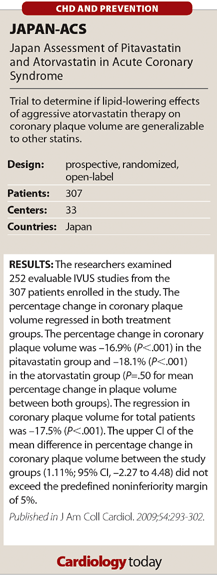JAPAN-ACS: Pitavastatin, atorvastatin both associated with reduction in plaque volume
Assigning pitavastatin or atorvastatin to patients with acute coronary syndromes was associated with a reduction in coronary plaque volume.
Researchers for the JAPAN-ACS study enrolled 307 patients with ACS who were undergoing IVUS–guided percutaneous coronary intervention. Patients were randomly assigned to either 4 mg/day of pitavastatin (n=153) or 20 mg/day of atorvastatin (n=154). The primary study endpoint was the percentage change in nonculprit coronary plaque volume.
The researchers reported that 252 of the 307 patients had evaluable IVUS exams at baseline and during follow-up. The percentage change in coronary plaque volume regressed in both treatment groups. The percentage change in coronary plaque volume was –16.9% (P<.001) in the pitavastatin (Kowa Pharmaceuticals America) group and –18.1% (P<.001) in the atorvastatin (Lipitor, Pfizer) group (P=.50 for mean percentage change in plaque volume between both groups). The regression in coronary plaque volume for total patients was –17.5% (P<.001). They also reported that the upper CI of the mean difference in percentage change in coronary plaque volume between the groups (1.11%; 95% CI, –2.27 to 4.48) did not exceed the predefined noninferiority margin of 5%. No differences in the prevalence of adverse events were reported between the study groups.
“Our study demonstrated that aggressive lipid-lowering therapy with either pitavastatin 4 mg/day or atorvastatin 20 mg/day achieved significant regression of the coronary plaque volume with negative vessel remodeling in patients with ACS based on a randomized, large-scale, multicenter, central IVUS core laboratory evaluation study,” the researchers wrote. “Therefore, the results provided support the hypothesis that administration of statins after the onset of ACS has the potential to reverse the process of atherosclerosis, thereby improving clinical outcome.”

Hiro T. J Am Coll Cardiol. 2009;54:293-302.
